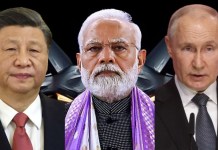Imagine Afghanistan.
What do you see?
Do you visualize poverty, refugees, drugs, suppressed voices, oppressed women, and structural violence?
Surely, Afghanistan tells a tale of destruction, terror, fear, and misery.
Today, the blueprints of disaster, inflicted since the 1970s, are imprinted on Afghan soil. Destroyed political institutions, absence of accountability and justice, weak armed forces and police, and deteriorating national economy are the outcomes of decades’ long tussle for power and influence. A pertinent question needs to be asked – who is to be blamed?
In the tussle of who would dominate Afghanistan, the world has deliberately neglected the sufferers on the ground – the ordinary Afghani citizen. Afghanistan is the world’s least peaceful country, and for the past four decades, frequent eruption of conflict and violence has paralyzed the nation.

In 2019 alone, over 10,000 civilians were killed in fighting between the US and the Taliban. In the first two months of 2020, the US conducted strikes in 27 out of 34 Afghan provinces.
Joel Charny, Executive Director, Norwegian Refugee Council, US, in an interview remarked, ‘Are the Taliban responsible for the current crisis? I could say quite honestly very minimally.’
If not them, then who should be held squarely responsible? How about the US?
The tragedy of 9/11 eliminated the contraband stratagem of the US and paved the way for its direct intervention in Afghanistan. The intent behind the intervention was to attain long-term stability through extinguishing the Taliban insurgency.
However, to date, the Taliban controls more territory than they had occupied in 2001 – marked as the US’ ‘exclusive’ achievement in Afghanistan. On the flip side, from 1970-90, the Mujahedeen were considered an asset by the US to fight Soviet Russia.
Robert Fisk writes that the ‘CIA camps trained Osama bin Laden’s fellow guerillas.’ Likewise, according to Mort Rosenblum ‘Osama bin Laden was the type of Soviet-hating freedom fighter that U.S. officials applauded when the world looked a little different.’
Nevertheless, after the collapse of Soviet Russia, the Mujahedeen were left to their own devices, hence, they turned against their masters.
Several scholars are of the view that Afghanistan entered a humanitarian and economic crisis due to the United Nations (UN) sanctions imposed from 2000 onwards under pressure from the US. The sanctions proved catastrophic for millions of Afghanis forcing them to flee the country, escape perpetual poverty and risk of serious human rights violations and abuses.
There are almost 2.6 million registered Afghan refugees who are not less vulnerable on foreign lands, as they are denied of their basic human rights, and even after generations remain in constant fear of deportation.
Despite the destruction and disaster inflicted by two wars and exploitation of land by innumerable non- state actors –Afghanistan stands. The Afghanis have remained resilient despite the world’s utmost efforts to stun them.
Unfortunately, many picture the least happy country – Afghanistan through the prism of 9/11.
Very few are interested in knowing what Afghanistan was like prior to the US invasion or before the Taliban or before USSR invasion or even before Afghan President Muhammad Daoud Khan.
In the 1950s and 60s, Afghanistan was a progressive, modern and literate country with rich culture and traditions. But the irony is, we know nothing about that except its tales of endless wars.
Afghan citizenry only wanted to get rid of foreign influence whether during the Soviet-Afghan war (1979-89) or after the US invasion of Afghanistan in 2001. The US policy-makers and military professionals certainly miscalculated their plans without factoring in communitarianism.
The Americans made the same mistake in Vietnam. For the Vietcong and North Vietnamese, the war was one of national liberation, while the Americans associated it with Domino Theory and transnational communism.
For the Taliban, the war has also been one of national liberation. However, Americans continue to associate it with transnational terrorism and al-Qaeda. Craig writes that ‘The spectre of Vietnam has hovered over Afghanistan from the start.’
Although the US’ exit from Afghanistan is inevitable, the current heavy monetary and military investments make it a more complicated undertaking. All US administrations have tried to justify the Afghan cause on the crutches of transnational terrorism, but the crucial decision to pull out continues to be left to successive governments.
Barack Obama left the determining decision of the future of US involvement in Afghanistan on his successor Donald Trump. So far, it seems that Afghanistan will slide into its third decade of suffering.
Hitherto, the future of Afghanistan seems dark. Although President Trump has repeatedly voiced his desire to leave the country sooner than the timeline under the February 29, 2020 Peace Agreement, one remains sceptical whether it is just a political stunt to win the elections.
While the answer to this remains vague, one thing which is for sure is that this war has been an albatross around the American establishment as one of its most expensive wars, in terms of dollars and human resources. At the same time, the Afghans have had enough of bloody coups, invasions, and civil wars. The world must respond to their pleas.
Just like German Chancellor Willy Brandt sank to his knees for half a minute, as though asking for forgiveness for what Nazi troops had done, at the Warsaw Ghetto in 1943, perhaps it is time for a US President to do the same in Afghanistan.
Ghanwah Ijaz is a researcher at the Centre for Aerospace and Security Studies (CASS). She can be reached at cassthinkers@gmail.com. VIEWS PERSONAL





